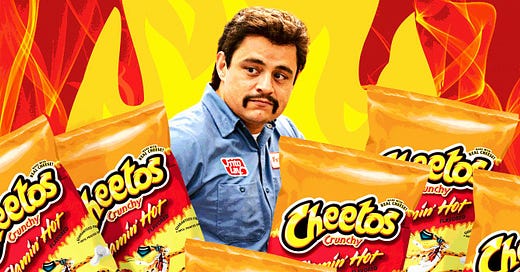Movie + snack pairing: Flamin' Hot and Flamin' Hot Cheetos
Consider me your sommelier, but for snacks and movies
This weekend, my family and I decided to watch the new film out now on Hulu and Disney+, Flamin’ Hot. I knew if my son watched the movie, he’d want to eat Flamin’ Hot Cheetos. So I decided we’d head to the supermarket to get some (where he also talked me into purchasing some Flamin’ Hot Doritos).
Eva Longoria directed the movie, which was based on the book A Boy, a Burrito, and a Cookie: From Janitor to Executive by Richard Montañez. The film tells the story of Richard Montañez, a janitor at Frito Lay who, according to the movie, came up with the idea for Flamin’ Hot Cheetos (the veracity of this is actually somewhat disputed; everything I cite below is as per the movie). Montañez is a Mexican American, and he based the flavors of the Flamin’ Hot spice blend on traditional Mexican flavors, drawing on traditional chiles and experimenting with his wife to get the blend of spices just right.
I never really thought of Flamin’ Hot Cheetos (and the other Flamin’ Hot branded foods and drinks, like Flamin’ Hot Doritos, popcorn, macaroni and cheese, and even Flamin’ Hot Mountain Dew) as being Mexican in origin or flavor, but then again, I honestly never gave too much thought to the whole Flamin’ Hot line before. As mentioned previously in this newsletter, as someone with terrible digestion, I generally can’t eat too many super spicy snacks. In fact, I can only tolerate a small handful of Flamin’ Hot Cheetos. I enjoy them — I just can’t eat a lot of them (which is, let’s face it, probably for the best).
Flamin’ Hot Cheetos came on the market in the ‘90s, and I wonder if, today, their packaging and marketing would read as more deliberately LatinX — although there are nods to Mexican-American/Californian culture with the font and use of flames in the logo. There is also one product in the line now called Flamin’ Hot Limón Cheetos that obviously uses the Spanish word for lemon or lime (apparently in Mexico, it typically means lime — and lime juice, not lemon juice, is an ingredient in these).
We enjoyed the movie. Montañez was likable as a flawed but determined man. He was easy to root for as a main character, and who doesn’t enjoy a rags-to-riches story? (I did find Montañez’s wife, who was very supportive of him throughout the film, was a bit one-dimensional; unfortunately, this film doesn’t pass the Bechdel Test). The (fictionalized) look at the inner workings of the Frito-Lay plant was fun, too. My husband has pointed out that there are a lot of movies coming out now that are about business triumphs — like the movies Tetris, BlackBerry, and Air (about Nike and Air Jordan sneakers). I don’t know what this says about us as a society (that we think capitalism is great?), but make of that what you will.
Of course, Flamin’ Hot Cheetos are absolutely considered an example of “ultra-processed foods”, “‘industrial formulations’ that combine large amounts of sugar, salt, oils, fats and other additives.” They are, in the wise words of Cookie Monster channeling Mark Bittman, a “sometime food.”
If you want to DIY your own Flamin’ Hot spice mixture, there are, of course, tutorials on how to do just that, using ingredients like cayenne, chili powder, cheese powder, salt, MSG, citric acid, buttermilk powder, onion powder, garlic powder, pepper, and red dye powder.
But more likely than not, you can find Flamin’ Hot snacks at a supermarket, convenience store, or big box retailer near you.
Have you seen the Flamin’ Hot movie? Do you like Flamin’ Hot snacks? Discuss!
Got a new snack you’d like me to write about? Let me know!
Want to share the love?
Have you subscribed yet? As an old-school pizzeria in Brooklyn once said to me the first time I ordered a pizza from them, “Where you been?”
Would you like to buy me a virtual coffee to go with my snacks?



